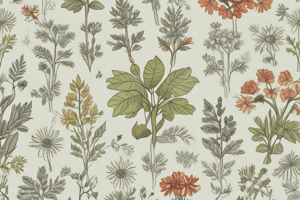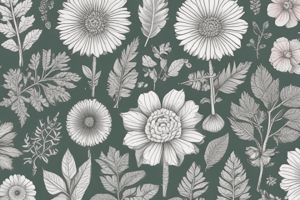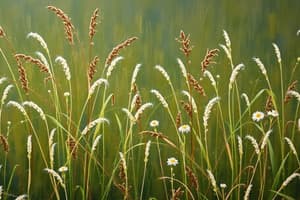Podcast
Questions and Answers
Cool-season annuals thrive in spring and fall, examples include pansies, snapdragons, and ______.
Cool-season annuals thrive in spring and fall, examples include pansies, snapdragons, and ______.
sweet peas
Warm-season annuals prefer summer heat; examples include marigolds, zinnias, and ______.
Warm-season annuals prefer summer heat; examples include marigolds, zinnias, and ______.
petunias
Soil preparation for planting requires well-draining soil rich in organic ______.
Soil preparation for planting requires well-draining soil rich in organic ______.
matter
During summer care, regular watering, deadheading spent flowers, and applying ______ helps retain moisture.
During summer care, regular watering, deadheading spent flowers, and applying ______ helps retain moisture.
Signup and view all the answers
To identify pests, monitor for common pests such as aphids, spider mites, and ______.
To identify pests, monitor for common pests such as aphids, spider mites, and ______.
Signup and view all the answers
Preventative measures in pest management include ensuring proper spacing and air ______.
Preventative measures in pest management include ensuring proper spacing and air ______.
Signup and view all the answers
In designing with annuals, use taller plants at the back of borders and shorter ones in the ______.
In designing with annuals, use taller plants at the back of borders and shorter ones in the ______.
Signup and view all the answers
Container gardening allows for mobility and variety in small ______.
Container gardening allows for mobility and variety in small ______.
Signup and view all the answers
Study Notes
Types Of Annual Plants
- Cool-season Annuals: Thrive in spring and fall; examples include pansies, snapdragons, and sweet peas.
- Warm-season Annuals: Prefer summer heat; examples include marigolds, zinnias, and petunias.
- Tender Annuals: Sensitive to frost; must be planted after the last frost date (e.g., impatiens, basil).
- Hardy Annuals: Can withstand light frost; can be sown directly outdoors (e.g., calendula, larkspur).
Cultivation Techniques
- Soil Preparation: Use well-draining soil rich in organic matter; perform soil tests for pH and nutrients.
- Seed Sowing: Start seeds indoors 6-8 weeks before the last frost or sow directly outdoors as appropriate.
- Watering: Keep soil consistently moist; avoid waterlogging and allow drainage.
- Fertilization: Use balanced, slow-release fertilizers; apply every 4-6 weeks during the growing season.
- Spacing: Follow recommended spacing for each variety to ensure proper air circulation and growth.
Seasonal Care
- Spring Care: Clear debris and weeds; sow seeds or transplant seedlings after frost risk has passed.
- Summer Care: Regular watering, deadheading spent flowers, and applying mulch to retain moisture.
- Fall Care: Remove spent plants; save seeds if desired; prepare beds for winterizing.
- Winter Care: In cold climates, consider using row covers or mulch to protect overwintering plants.
Pest Management
- Identifying Pests: Monitor for common pests such as aphids, spider mites, and whiteflies.
- Cultural Practices: Promote beneficial insects (ladybugs, lacewings) and maintain plant health through good practices.
- Chemical Control: Use insecticidal soaps or neem oil; apply early in the morning or late in the evening to minimize harm to beneficial insects.
- Preventative Measures: Ensure proper spacing and air circulation; rotate crops to prevent pest buildup.
Designing With Annuals
- Color Schemes: Plan color combinations based on seasons and flowering times; consider contrasting and complementary colors.
- Height Variation: Use taller annuals in the back of borders and shorter ones in the front for visual interest.
- Seasonal Rotations: Incorporate different annuals each season to refresh garden appearance.
- Container Gardening: Use annuals in pots for mobility and variety in small spaces; mix different plants for texture and color.
- Focal Points: Utilize bold annuals as focal points within a garden design to draw attention.
Types Of Annual Plants
- Cool-season Annuals: Best suited for spring and fall; notable examples include pansies, snapdragons, and sweet peas.
- Warm-season Annuals: Thrive in summer heat; typical varieties are marigolds, zinnias, and petunias.
- Tender Annuals: These plants are frost-sensitive and should be planted post-last frost date; examples include impatiens and basil.
- Hardy Annuals: Capable of withstanding light frost; can be directly sown outdoors; examples include calendula and larkspur.
Cultivation Techniques
- Soil Preparation: Requires well-draining soil with organic matter; soil tests are recommended to check pH and nutrient levels.
- Seed Sowing: Indoors sowing should occur 6-8 weeks before the last frost, while some can be directly sown outdoors depending on timing.
- Watering: Maintain consistently moist soil; prevent waterlogging and ensure proper drainage.
- Fertilization: Utilize balanced, slow-release fertilizers every 4-6 weeks throughout the growing season.
- Spacing: Adhere to recommended spacing guidelines for each variety, essential for air circulation and growth.
Seasonal Care
- Spring Care: Clear out debris and weeds; sow seeds or transplant seedlings following the last frost risk.
- Summer Care: Focus on regular watering, deadheading spent flowers, and applying mulch for moisture retention.
- Fall Care: Remove spent plants, collect seeds as needed, and prepare flower beds for winter.
- Winter Care: In colder areas, consider row covers or mulch for protection of overwintering annuals.
Pest Management
- Identifying Pests: Regularly check for common pests like aphids, spider mites, and whiteflies.
- Cultural Practices: Encourage beneficial insects such as ladybugs and lacewings, and ensure plant health through proper practices.
- Chemical Control: Apply insecticidal soaps or neem oil, preferably early in the morning or late in the evening to limit impact on beneficial species.
- Preventative Measures: Optimize spacing for air circulation and incorporate crop rotation to minimize pest populations.
Designing With Annuals
- Color Schemes: Develop color palettes based on the seasons and flowering cycles; utilize contrasting and complementary colors for impact.
- Height Variation: Position taller annuals at the back of garden borders while placing shorter ones at the front to enhance visual intrigue.
- Seasonal Rotations: Refresh garden aesthetics by rotating different annual varieties each season.
- Container Gardening: Employ annuals in pots for flexibility and variety, allowing for combinations of plants to enhance texture and color.
- Focal Points: Implement bold annuals as focal points in the garden design to attract attention and create visual highlights.
Studying That Suits You
Use AI to generate personalized quizzes and flashcards to suit your learning preferences.
Description
Explore the various types of annual plants, including cool-season, warm-season, tender, and hardy annuals. This quiz will also test your knowledge on essential cultivation techniques such as soil preparation, seed sowing, and watering methods relevant to gardening.




